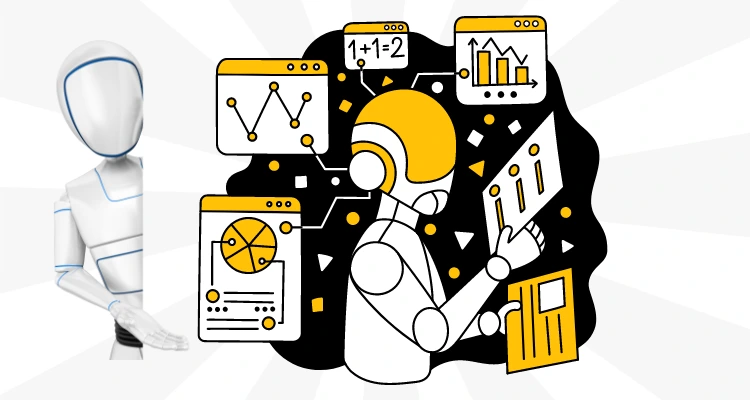- Home
- -Blog
The Future of Software Development is Cloud-Native

- Updated on 07 Oct 2024
- Shabir Ahmad
What is Cloud-Native Development?
Cloud-native development refers to building and running
applications designed specifically for cloud environments.
Instead of relying on traditional servers, cloud-native
applications use a combination of
microservices, containers, and DevOps
practices to ensure scalability, flexibility, and
resilience.
These applications are deployed and
managed across cloud platforms, allowing businesses to
benefit from faster updates, improved efficiency, and
better resource utilization.
The Growing Trend of Cloud-Native Adoption
In recent years, many businesses are shifting toward
cloud-native development. According to industry reports,
80% of enterprise applications will
either be cloud-based or transitioning to cloud-native by
2025 .
This shift is driven by the need for greater
agility, cost-effectiveness, and the
ability to innovate rapidly. By adopting cloud-native
architecture, companies can respond faster to market
changes, deploy features continuously, and scale
efficiently without overburdening their resources.
Key Characteristics of Cloud-Native Development
| Characteristic | Description | Key Tools |
|---|---|---|
| Scalability | Automatically adjusts resources based on user demand. | Kubernetes, Docker |
| Resilience | Designed to function despite failures by distributing services. | Microservices, Self-healing containers |
| Automation | Automates deployment, scaling, and monitoring tasks. | CI/CD pipelines, Kubernetes |
Difference Between Monolithic and Cloud-Native Applications
In traditional monolithic applications, all components are tightly integrated into a single large codebase. Scaling a monolithic app requires duplicating the entire application, which is resource-intensive and costly. Additionally, updates in one area of the code can affect the entire system, leading to potential disruptions.
In contrast, cloud-native applications break down functionality into microservices. Each microservice runs independently and can be updated or scaled without affecting other parts of the system. This makes cloud-native apps more flexible, cost-efficient, and easier to maintain.
The Rise of Cloud-Native in Small and Medium Enterprises (SMEs)
How SMEs Are Adopting Cloud-Native Technology
In recent years, small and medium enterprises (SMEs) have begun embracing cloud-native development to achieve the kind of scalability and cost-efficiency that was once only accessible to large enterprises. Cloud-native technologies, such as microservices and containerization, allow SMEs to rapidly scale their applications without investing in costly on-premise infrastructure.
This makes it easier for smaller businesses to respond to changing demands and market conditions without the resource constraints typically associated with scaling.
Cloud-native solutions offer pay-as-you-go models, enabling SMEs to avoid upfront capital expenses and only pay for the computing resources they actually use. With tools like Kubernetes for container orchestration, SMEs can dynamically adjust their resources to meet customer needs while keeping costs under control.
Additionally, by adopting DevOps practices, SMEs are streamlining their operations and reducing development cycles. This allows them to roll out new features faster and maintain a competitive edge even against larger, more established competitors.
Cloud-Native's Role in Sustainable Software Development

How Cloud-Native Architecture Contributes to Sustainability
Cloud-native development is playing an increasingly important role in driving sustainable software development by optimizing resource usage and reducing overall energy consumption. By designing applications with scalability, efficiency, and automation in mind, cloud-native solutions can significantly minimize the energy and computational resources required to run applications.
One of the key factors in making cloud-native systems more sustainable is the dynamic scaling of resources. Unlike traditional on-premise infrastructure, where servers run continuously regardless of the demand, cloud-native applications scale up or down automatically based on real-time needs. This ensures that only the necessary amount of computing power is used, which leads to lower energy consumption and reduced carbon emissions.
Additionally, containerization allows cloud-native applications to be lightweight and efficient. By isolating microservices within containers, developers can optimize each component of the application independently, reducing resource waste and improving overall efficiency. This contrasts sharply with traditional monolithic applications, where scaling the entire system for a single functionality increases unnecessary resource consumption.
Serverless Architectures and Lower Energy Waste
Serverless architectures further enhance the sustainability of cloud-native development by reducing energy waste. In a serverless environment, applications only consume resources when triggered by an event, rather than running continuously.
This approach drastically lowers energy consumption by eliminating idle server time. Serverless computing also automatically allocates just the right amount of resources needed to handle incoming requests, scaling up and down in real time.
For instance, an application using serverless functions will automatically scale to meet user demands, meaning that during periods of low usage, fewer resources are consumed. As a result, serverless computing reduces the environmental impact of running applications at scale by only utilizing the energy needed for specific tasks, avoiding the resource-intensive nature of always-on servers.
In this way, serverless technologies, combined with the broader principles of cloud-native architecture, allow businesses to reduce their energy footprints and contribute to a more sustainable future while still maintaining application performance and availability.
Security in a Multi-Cloud and Distributed Environment

Key Security Challenges in Cloud-Native Setups
In a cloud-native environment, particularly in multi-cloud and distributed setups, security becomes more complex due to the decentralized nature of these systems. Unlike traditional on-premise solutions, where security measures are confined to a single infrastructure, multi-cloud environments must address security across various providers and regions. Some of the main security challenges include:
- Data protection across different platforms: Sensitive data is transmitted across multiple cloud services, increasing the risk of exposure or interception.
- Managing identities and permissions: Ensuring consistent authentication and authorization processes across distributed systems can be challenging, especially when different clouds have unique security protocols.
- API vulnerabilities: Cloud-native architectures rely heavily on APIs for communication between microservices. APIs are frequent targets for attacks, making it essential to secure them against unauthorized access.
- Container security: While containers are efficient, they introduce new security risks. Malicious actors could potentially exploit vulnerabilities within containerized environments, impacting the entire application.
Methods and Tools to Mitigate Risks
| Security Measure | Purpose | Key Tools |
|---|---|---|
| mTLS | Secures communication between microservices. | mTLS (mutual TLS) |
| OAuth | Secures API access and prevents unauthorized data sharing. | OAuth protocol |
| Continuous Monitoring | Tracks performance, detects threats, and alerts teams in real-time. | Prometheus, Grafana, Elasticsearch |
Developer Experience (DevEx) and Cloud-Native Development
Impact of Cloud-Native Tools on Developers' Workflows
Cloud-native development introduces a set of tools and practices designed to streamline workflows, but it also brings new challenges. Tools like Kubernetes, Docker, and Prometheus allow developers to manage, deploy, and monitor containerized applications across cloud environments with greater flexibility. These tools, when paired with a Kubernetes storage platform, offer the benefit of automating repetitive tasks, reducing manual intervention, and providing scalability.
However, with this increased flexibility comes complexity. Developers often have to navigate a larger number of tools and technologies, which can create a steep learning curve.
For example, managing microservices introduces new responsibilities like monitoring each service individually and troubleshooting failures across distributed systems. While cloud-native tools increase productivity, they also require developers to be familiar with concepts like container orchestration and distributed tracing, which adds cognitive load to their daily workflows.
Automation and Cognitive Load
One of the key benefits of cloud-native development is the use of Continuous Integration/Continuous Delivery CI/CD pipelines to automate the build, testing, and deployment processes. CI/CD allows developers to push changes rapidly, ensuring that new features or bug fixes reach production environments quickly.
While automation through CI/CD reduces the time spent on manual processes, it also introduces potential cognitive overload. Developers are now expected to handle not just code, but the entire lifecycle of the application, from deployment to monitoring and performance optimization. The "you build it, you run it" model, common in cloud-native setups, places additional pressure on developers to oversee infrastructure monitoring, and incident management, alongside their coding responsibilities.
Improving DevEx Through Better Toolchain Integration
To improve Developer Experience DevEx in a cloud-native environment, companies need to focus on simplifying workflows and reducing unnecessary complexity. Here are some ways to enhance DevEx:
- Toolchain Integration
- Consistent Processes
- Reducing Tech Sprawl
Many organizations suffer from tool sprawl, where multiple disconnected tools are used to manage different parts of the development lifecycle. This can overwhelm developers as they switch between tools for coding, testing, deployment, and monitoring. By integrating tools into a cohesive pipeline, companies can reduce context switching and make workflows more efficient. For example, integrating CI/CD pipelines with monitoring tools like Prometheus or Grafana provides end-to-end visibility in a single interface.
Establishing standardized processes for tasks like testing, deployment, and monitoring can help reduce the cognitive burden on developers. When processes are consistent and repeatable, developers spend less time troubleshooting or trying to figure out the best way to execute tasks. Adopting DevOps principles, where teams collaborate closely and follow the same practices, can help align these processes.
Minimizing the number of tools in the development pipeline can alleviate the strain on developers. Instead of using a variety of specialized tools, companies should focus on platforms that offer multiple functionalities or better integrations. For instance, using a unified platform like Kubernetes for container orchestration, coupled with CI/CD tools, reduces the complexity of managing distributed systems and microservices.
The Integration of AI, Machine Learning, and Cloud-Native Development

How Cloud-Native Platforms Foster AI/ML Innovation
Cloud-native development and artificial intelligence AI or machine learning ML are increasingly interlinked, with cloud-native platforms serving as a perfect foundation for AI and ML innovation. Cloud-native infrastructure provides the flexibility, scalability, and performance required to build and deploy complex AI/ML models efficiently. By leveraging containers, microservices, and serverless computing, AI/ML applications can scale dynamically and handle high-performance tasks like real-time data processing.
One of the key advantages is that cloud-native platforms allow for the rapid deployment and iteration of AI models. Developers can continuously update AI algorithms, improve accuracy, and deploy them in production environments without major disruptions. Additionally, with cloud-native's distributed architecture, data scientists can easily manage large datasets across different cloud environments.
Furthermore, cloud-native environments support the integration of ML Ops Machine Learning Operations, automating the end-to-end machine learning lifecycle, from data collection to model deployment and monitoring. This ensures that AI applications can quickly adapt to changing data patterns and user needs without requiring significant manual intervention.
Examples of AI-Driven Cloud-Native Applications Reshaping Industries
Healthcare
A suitable example of AI-powered cloud-native applications in healthcare is GE Healthcare's Edison AI platform. This cloud-native platform integrates AI models to assist doctors in making faster, more accurate diagnoses using real-time data from medical devices such as MRI and CT scanners. In addition, advancements in healthcare technology create new opportunities, including medical courier jobs that ensure timely delivery of critical medical supplies and equipment.

The platform helps radiologists detect abnormalities in medical images, enabling them to offer personalized treatment plans based on patient-specific data.
By leveraging cloud-native infrastructure, Edison ensures that these AI models can scale according to demand, providing real-time diagnostics while maintaining the security and privacy required in healthcare settings.
- Finance
- Retail
A great example of cloud-native AI applications in the financial sector is HSBC's use of AI for fraud detection and personalized services. HSBC, one of the world's largest banking institutions, has integrated AI-driven cloud-native solutions to monitor transactional data and flag suspicious activities in real time.

Their system can detect anomalies and potential fraud by analyzing patterns across millions of global transactions. Moreover, HSBC uses AI-powered virtual assistants to provide customers with personalized financial advice, helping users manage accounts, track spending, and even automate savings.
A great example of a retail business leveraging cloud-native AI tools is Amazon. Through its cloud-native infrastructure, Amazon uses AI-driven algorithms to analyze shopping patterns, customer preferences, and purchase history in real-time.

This enables the platform to provide highly personalized product recommendations to individual users at scale. Additionally, Amazon's cloud-native inventory management system uses real-time stock monitoring to ensure that products are available when customers need them.
By predicting demand through AI and adjusting inventory levels accordingly, Amazon optimizes its supply chain, reducing delivery times and minimizing stockouts.
Cost Management in Cloud-Native Development
How Cloud-Native Development Reduces Costs
One of the key advantages of cloud-native development is its ability to reduce costs through efficient resource utilization and dynamic scaling. Unlike traditional infrastructures, where businesses must invest in and maintain costly hardware upfront, cloud-native environments operate on a pay-as-you-go model. This means that companies only pay for the resources they actually use, eliminating the need for overprovisioning.
Dynamic scaling is another cost-saving factor. Cloud-native applications can automatically adjust resource usage based on real-time demand. For instance, during peak traffic, the application scales up, adding more containers or microservices to handle the load. During quieter periods, resources scale down, reducing operational costs. This ability to automatically match resource consumption to user demand significantly lowers infrastructure costs, particularly for businesses with fluctuating workloads.
Additionally, cloud-native development allows companies to optimize infrastructure costs by deploying applications in multiple cloud regions or across different cloud providers. This flexibility enables businesses to take advantage of the most cost-effective cloud offerings while ensuring optimal performance and availabilityy.
Tools and Strategies for Managing Cloud-Native Costs
| Strategy | Purpose | Tools |
|---|---|---|
| Kubernetes Cost Management | Monitors resource utilization and identifies cost-saving opportunities. | Kubecost, Kube-resource-report |
| Auto-Scaling & Spot Instances | Automatically adjusts resources and utilizes spare capacity at lower costs. | AWS Auto-Scaling, Google Cloud Auto-Scaler |
| Rightsizing Resources | Optimizes resource allocation to minimize waste. | CloudHealth, AWS Cost Explorer |
The Shift to Serverless Architectures in Cloud-Native Development
What is Serverless Computing?
Serverless computing is a cloud-native development model where developers build and deploy applications without managing the underlying infrastructure.
In a serverless architecture, cloud providers like AWS, Google Cloud, or Azure automatically allocate resources based on application needs, handling all server management tasks, such as provisioning, scaling, and patching.
In a serverless environment, developers focus solely on writing code, while the cloud provider manages everything else. With serverless, applications are event-driven, meaning that computing resources are only used when a specific function is triggered. For instance, when an API call or a user action occurs, the relevant functions execute, and resources are consumed only for the duration of that event.
Integration of Serverless Computing in Cloud-Native Architectures
In cloud-native architectures, serverless computing fits seamlessly by allowing applications to run on-demand. It eliminates the need for developers to worry about scaling or server maintenance, making it easier to integrate microservices and containers. Serverless can also be combined with other cloud-native tools like Kubernetes to create highly efficient, scalable, and resilient systems.
For example, in an e-commerce platform, serverless functions could handle user interactions, process payments, and update inventory in real-time, all without the need for a dedicated server running constantly. This level of automation and flexibility is key to cloud-native development, where agility and efficiency are critical.
Advantages of Serverless Computing
- Reduced Infrastructure Management
- Cost Efficiency
- Increased Agility
- Auto-Scaling
One of the primary advantages of serverless computing is the elimination of infrastructure management. Developers no longer need to manage or provision servers, reducing operational overhead. Tasks such as scaling, load balancing, and server maintenance are handled automatically by the cloud provider. This allows development teams to focus on writing code and delivering features faster.
Serverless operates on a pay-as-you-go model, where businesses only pay for the actual compute time used during function execution. This is in contrast to traditional cloud setups where you pay for server uptime, even when the server is idle. By using serverless, businesses can avoid over-provisioning resources, making it a more cost-effective option.
Serverless computing significantly increases development agility by streamlining deployment and reducing the time it takes to bring new features to market. Developers can push updates faster because serverless systems handle scaling and capacity automatically. This rapid iteration enables businesses to respond to user demands more quickly, allowing for continuous improvement and innovation.
Serverless platforms can automatically scale up during peak traffic times and scale down when demand is low. This feature ensures that applications always have the resources needed to handle fluctuating workloads without wasting resources during downtime. For businesses with unpredictable traffic patterns, this flexibility is a major advantage.
Conclusion
Cloud-native development is rapidly becoming the foundation for the future of software development. By embracing microservices, containers, and serverless architectures, businesses can achieve greater scalability, resilience, and agility. This modern approach not only reduces infrastructure costs but also enables rapid innovation, allowing companies to respond swiftly to changing market demands.
The future of software development is undeniably cloud-native. As companies continue to adopt this architecture, they will benefit from enhanced performance, reduced operational costs, and the ability to innovate faster than ever before. Whether through serverless computing, real-time edge processing, or the integration of AI, cloud-native technologies are reshaping the way software is developed, deployed, and scaled.



